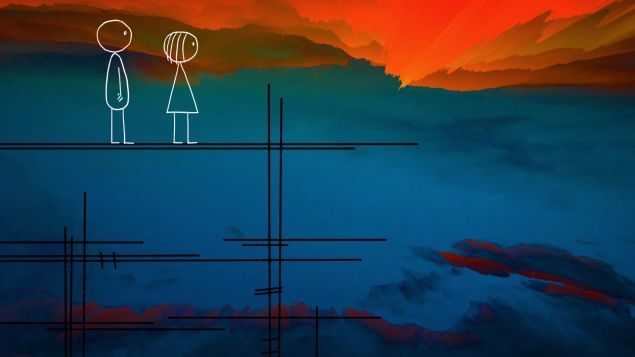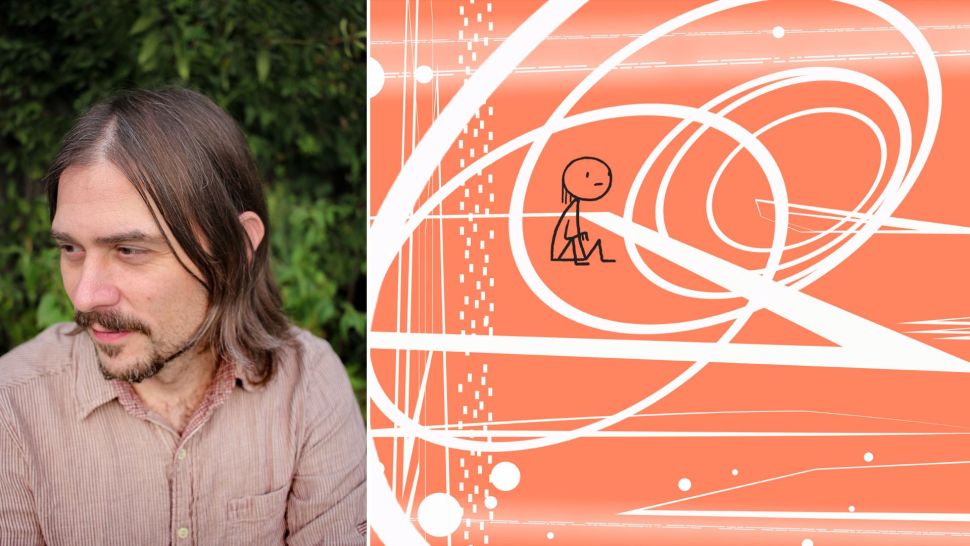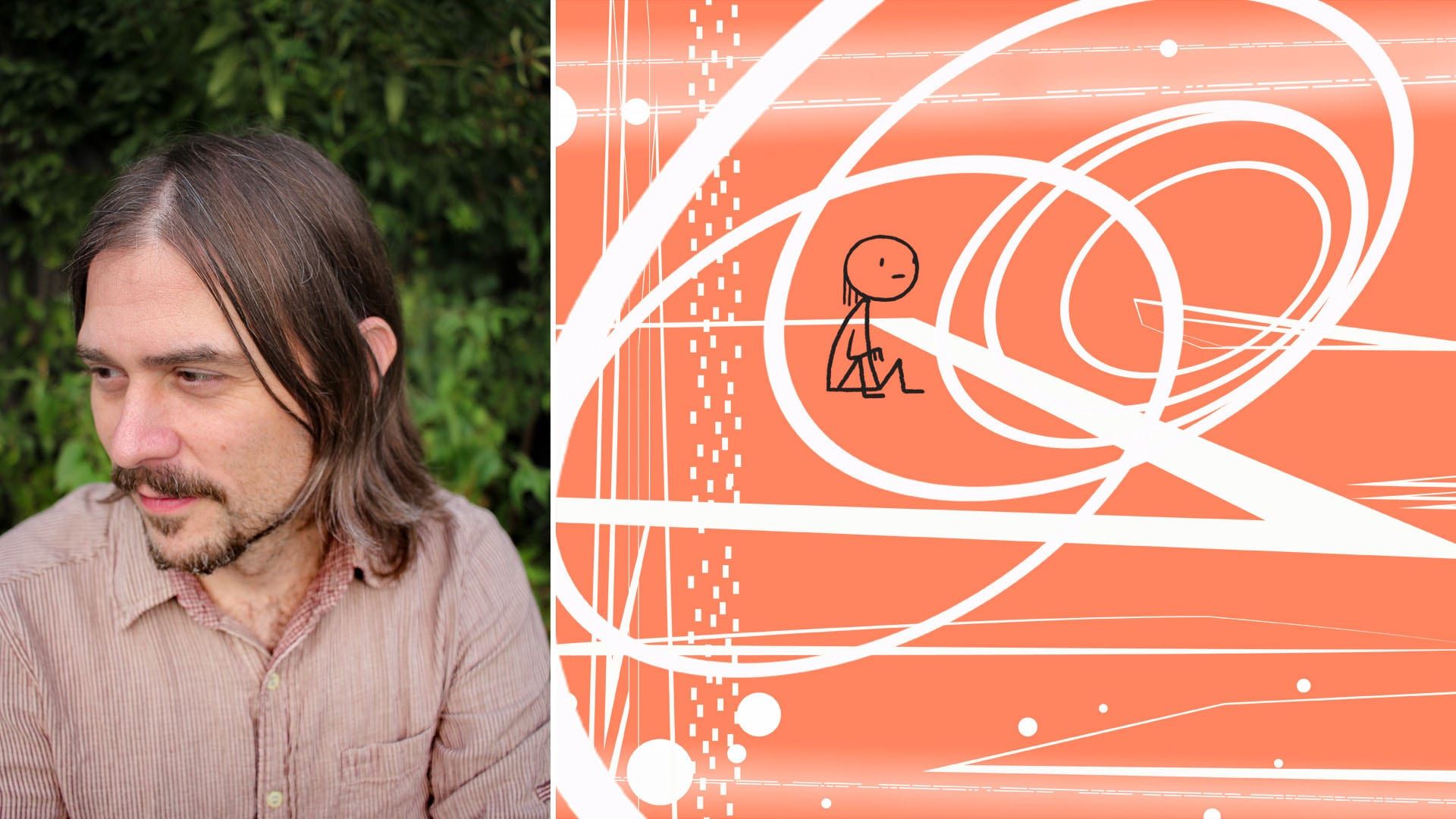
L: Animator and director Don Hertzfeldt. R: World of Tomorrow Episode Two. Don Hertzfeldt
Two-time Oscar nominated animator Don Hertzfeldt just crossed the $350,000 threshold in his massive campaign to bring World of Tomorrow, a series infused with time travel, clones and futuristic technology, to Blu-ray. The campaign symbolizes the dedication of Hertzfeldt’s fanbase, who have followed his career since its genesis in the early 2000s.
Hertzfeldt’s shrewd, fatalistic and occasionally self-deprecating wit bleeds through most of his work. Hertzfeldt said it best himself in the description of his latest Kickstarter campaign: “I’m like PBS but with more screaming.†And over the years, his following and recognition has only grown. Billy’s Balloon played at Cannes film festival, Rejected earned an Oscar nomination and Everything Will Be OK landed an award at Sundance film festival. That’s just the short list.
But perhaps the most enduring aspect of Hertzfeldt’s work is its sneaky ability to force the viewer to ruminate on life, loss and the way in which time often trivializes many of our fleeting preoccupations. In World of Tomorrow, Emily inhabits an alternate science fiction universe in which she is visited by a copy of herself 200 years in the future. And in the latest episode, a clone named David is forced to clear space on his hard drive and shut down basic human emotions such as empathy in order to survive. One of the most poignant lines from the series: “Now is the envy of all of the dead.†With ambitious and intricate animated backdrops accompanying the brilliant storyline, it seems like a crime not to render World of Tomorrow in Ultra HD.
In an email interview, Hertzfeldt spoke with Observer about his creative process, relationship with his fanbase and plans to collaborate on future animated projects.
Observer: How did the switch from using 35mm film and old school multiplane cameras to digital change the process of creating World of Tomorrow?
With my old 35mm Rostrum cameras, the animation would sit on top of a platform, with the camera mounted on a crane above it. These were eight-feet-tall, 800-pound camera stands and you’d sit there with your giant stacks of paper, shooting each drawing one at a time in succession for hours and hours under these lights. And if you wanted to put a camera move into a shot, there were all these little manual knobs with incremental measurements all over them to move your artwork left, right, up, or down — and the camera crane itself could incrementally travel up and down, to push in or out. Every operation is measured at one frame at a time, so you’d have to work out all this careful math to get the movement to look right in concert with your artwork. And you quickly learn that there’s a reason animators didn’t used to shoot their own stuff, it can get really complicated and all the studios would have a dedicated crew.


World of Tomorrow Don Hertzfeldt
The last thing I’d usually want to do was make life more difficult for myself in the camera room, so in the early years i would try to really limit the camera moves and keep all the setups pretty simple. For the same reason — exhaustion — you didn’t see a lot of color or backgrounds in my older stuff, either. And as a result those early films had a certain detachment to them. The camera sort of felt abandoned somewhere, passively capturing characters that were sort of awkwardly wandering around in front of it, in these long takes. When I started It’s Such a Beautiful Day, I got around the problem of not being able to move the camera by dividing the film frame itself up into smaller frames that were composited through multiple exposures — which I could then zip around independently.
As a director I realized I’d been working like a guitarist who’d only been playing on five of the guitar strings his whole life, having long ago forgotten that there’s a sixth.
Moving to digital in 2014 sped everything up and made life easier in lots of departments — colors! Backgrounds! And the camera could fly all over the place now, but I still had this really weird resistance to ever wanting to move it. I kept visualizing my shots and angles in this really restrained way. After 20 years of having to compose shots in cement, I’d become so trained that the thought of moving the camera at all almost felt tacky. It was a serious mental block that I only just started to get around with World of Tomorrow Episode Three, which really demanded a more curious camera and compositions. As a director I realized I’d been working like a guitarist who’d only been playing on five of the guitar strings his whole life, having long ago forgotten that there’s a sixth.
One of the themes of World of Tomorrow is the idea of a technology that allows you to live forever actually takes away the aspects of humanity that make it precious (such as memory). Are these themes you decide to explore before beginning animation or do they gradually evolve throughout the process?
The shape of a script and most of the dialogue is in place by the time I start animating, but the process of designing and visualizing everything brings out all sorts of new flavors and more interesting stuff. When you’re stuck spending two years on a single project like Episode Three, you’re bound to come up with better ideas as you go. It’s really important for me to be open to everything that might float along. I have an old Post-It note on one of my doors where I wrote, “You can do anything.†It’s not meant to be like an inspirational cat hanging on a branch sort of thing, it means you can do anything creatively. I always need to remind myself that if I ever feel cornered, these scripts can always change and improve into something else at any point. It has to stay elastic and free or none of this is going to be very fun.
It wasn’t until I was mixing the final soundtrack that I realized I’d been too dumb to notice that this death was itself a form of drowning. So I recut it and remixed it to bring that forward. Big chunks of the stories were written sort of meanderingly like this.
When I was writing Episode Three, I remember reading a book about people who had near-death experiences, where they say they saw their lives flash before their eyes. And I’ve always thought the idea of that actually seemed like a really humiliating, invasive thing to happen. It’s too embarrassing to even look through an old photo album. And that reaction struck me as kind of funny, so I decided to write it for David as a 13-year-old, since everything feels embarrassing at that age. So his near-death drowning was only in there at first because I wanted to fit the line in the movie, “His life flashed before his eyes, totally humiliating him for a second time.†But that also creates a great starting point to find other connections for the character as you write. He shares memories with Emily, which brought me to another good line, “Sometimes I look forward to drowning together when I turn out the light,†and that deepened their connection. As an old man, his body dissolves in some sort of fluid as he’s cloned. It wasn’t until I was mixing the final soundtrack that I realized I’d been too dumb to notice that this death was itself a form of drowning. So I recut it and remixed it to bring that forward. Big chunks of the stories were written sort of meanderingly like this, just sort of feeling through and connecting scenes and ideas that aren’t very clear until you see them plainly in front of you. I think people might be surprised by how much is just sort of stumbled upon rather than plotted out.
It’s been a weirdly pure way of making movies… just me and an audience, with no one in between. There’s no pitching, no accounting, no meetings.
What influenced the decision to make a Blu-ray version of the films and to get fans involved in the process with Kickstarter?
When we first tried out Kickstarter years ago, for the first Blu-ray, it just seemed like a smart way to figure out whether anyone was still even interested in physical media. It let us measure how many people wanted to sign up for the title, rather than have to blindly guess how many copies to print and store. But it was such a runaway success that the campaign grew into more of an overall fundraiser for future projects.


World of Tomorrow Episode Three Don Hertzfeldt
The fans have been very involved since the beginning, over 20 years ago. Without them, I’d really have had to quit doing this a long time ago. I’ve never received a big grant or had a studio job. Distribution has always been a little haphazard and I don’t know if I’ve worked with a publicist more than a few times. But the audiences have always shown up to buy tickets anyway. They’re truly the reason this stuff exists, it’s always been profitable. You just can’t spend all that time making a super strange animated short film unless there’s people out there really waiting for it.
I’ve realized it’s been a weirdly pure way of making movies… just me and an audience, with no one in between. There’s no pitching, no accounting, no meetings. If a major distributor were to never materialize to help out, I’m probably in a place now financially where I could just keep making things like this indefinitely — for the current Kickstarter I’ve written, “I am like PBS, but with more screaming†— the problem is, it’s just going to continue to be incredibly slow.
You’ve called World of Tomorrow your “science fiction sandbox†— did you feel that the science fiction and time travel setting lended itself to greater creative freedom?
Definitely, the series has been the most fun thing I’ve worked on. There are no boundaries. You can bring people back from the dead, send them into different dimensions, torture them with memories that aren’t their own, what’s not to love?
One of the creative elements of World of Tomorrow is its transfusion of comedy or parody into an intense and dark plotline — how do you maintain an element of humor in a world that seems bleak or terrifying?Â
When the world is at its most bleak and terrifying, a sense of humor is often your last line of defense. In so many of the survival stories I’ve read, when someone loses their sense of humor, whether in a concentration camp or trapped in an icy cave, that’s the point when their friends know they’ve lost them.
What sparked your early interest in animation?
I always wanted to make movies, but if you shot live-action at age 15, it meant casting your short friend to play the hard-boiled detective and shooting in your mom’s kitchen with the cat walking by. It’s never going to look right. Animation was a way to make a movie back then with less. You didn’t need a lot of help or money if you were willing to put in the time, and you didn’t have the limitations of your mom’s kitchen.
Looking back on the evolution of ways your work has been distributed — with platforms such as DVDs, Hulu, Vimeo, YouTube and Blu-ray, how have these various mediums impacted your proximity to your audience and the way you think about sharing your work?
Nobody has ever really known what to do with short films, so even when I was in film school I just tried to follow the release pattern of whatever a normal movie does. You go from theaters to home video to TV and now streaming. And because I’ve always been animating alone in a sort of bubble, I think theaters have always been an especially important step for me. After working on something in the dark for so long, it was always really helpful just psychologically to see real people show up and take this thing in. I’ve always said it’s like wanting to be there to watch a friend open a present that you’ve made for them. Getting out of the house and touring with a new thing used to really help recharge my batteries and kind of reminded me what the point of this all was.
With the COVID-19 shutdown last year, World of Tomorrow Episode Three was the first one I made that didn’t premiere in a theater. We had a distributor ready to bring it to theaters nationwide and then the whole thing crashed against the rocks. I think it hit me surprisingly hard to not get that same experience with people. I just sort of got this heavy feeling of anticlimax instead. It’s been streaming instead and the new Blu-ray is on the way, which are still pretty big miracles, but I’m afraid those things are only going to sort of deepen the bubble I’m already in. If a number on a page says 1,000 people watched your movie or 1,000,000 people watched your movie, those numbers don’t really feel so different to me. At a certain point there’s kind of a “Who cares?†when you’re just looking at figures without any human feedback. It starts to sort of feel like you’re just feeding a machine.
With plans to introduce a bigger animation team for the fourth episode of World of Tomorrow, what have you noticed are the advantages or disadvantages with collaborating more extensively on these projects?Â
Though I could carry on like this alone, there does come a point in your life when spending another few years to produce just 30 minutes of footage starts to weigh on you. It seems really weird that I’m still hand-coloring every frame of the characters in Photoshop, right? I’ve been finding myself getting more and more jealous of people in other positions, like actors, who could be involved with multiple projects in a year and still have time for a vacation.
With a team of animators, even just a skeleton crew, we could cut those years down to something more reasonable. And it would be fun to collaborate. But animators are expensive and I’ve never wanted to be the guy to make interns work for free. We’ve been having ongoing conversations with streamers for over a year, and COVID messed up a lot of those plans too, but I’m still confident all of this will end up somewhere that feels like a home. If I need to continue working alone I’m just afraid I might drop dead of old age before I can get to everything.
World of Tomorrow: The First Three Episodes is available to back on Kickstarter until March 11 2021 1:58 PM EST.

